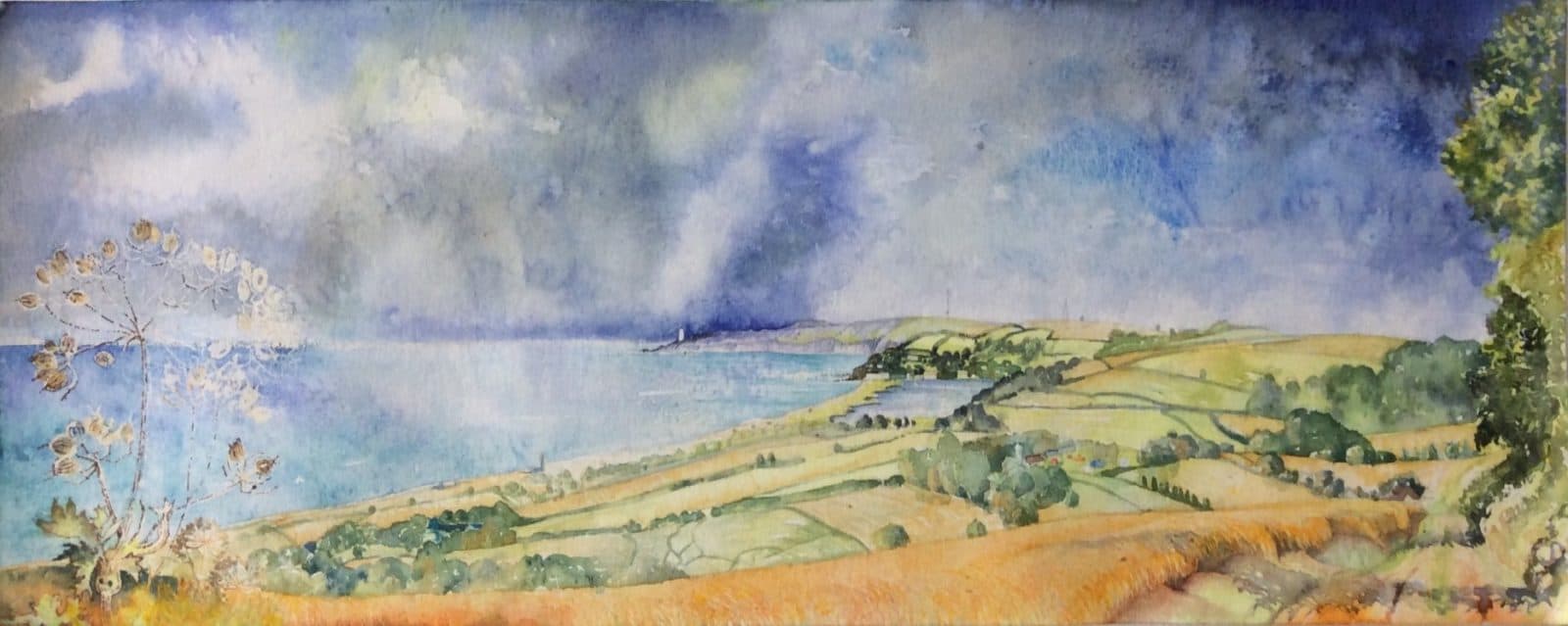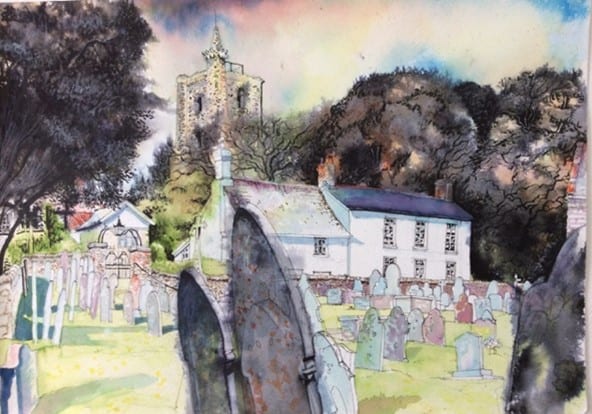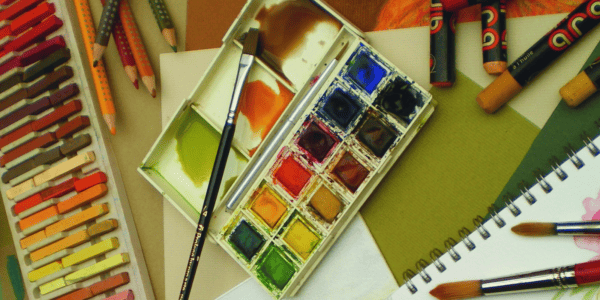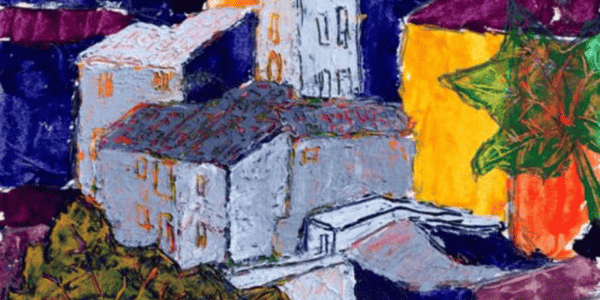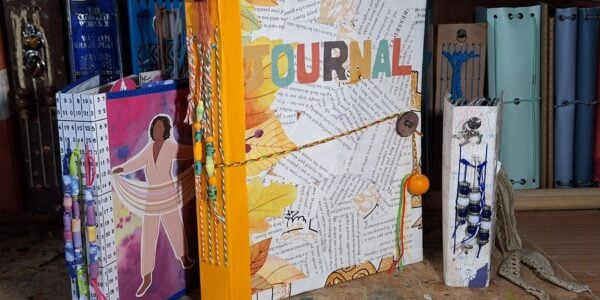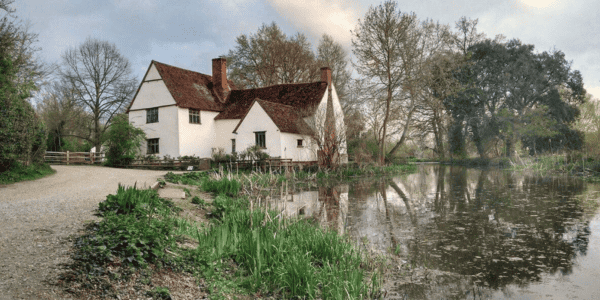The aim of this course, open to all abilities, is to enjoy building up confidence in drawing and painting.
Although you may bring any medium to use including oil and acrylic, Hilary’s daily demonstrations will include drawing, pen, ink and wash, watercolour and body colour. For those who wish to learn about colour theory, there will be colour mixing workshops, where you can create secondaries, tertiaries and tints, understand tone and discover how to use complementary colours to reduce intensities.
The days will be spent outside on-location sketching and painting around the beautiful Slapton Ley National Nature Reserve, the local Devon coast, Dartmoor and the buildings of the lovely village of Slapton. During en plein air drawing and painting sessions, we will also gather references which can then be continued with or developed from in evening sessions. We will also explore form, pattern and texture and perspective. Evening excursions at sunset, dusk or twilight will provide us with an exciting range of atmospheric effects to experience and paint.
The aim of this course, open to all abilities, is to enjoy building up confidence in drawing and painting. Hilary does not teach in a prescriptive way, but you will learn to appropriate skills and techniques with confidence through application.
The beginning of the course will include understanding and mixing colour, using harmonies, hot and cold colours, split complementaries, tertiaries and tints and we will work in both monochrome and a limited palette to produce short ‘timed’ paintings.
But there will also be opportunities for longer paintings in situ, in the medium of your choice.
Most of the locations are easy to access, however getting to some of the best viewpoints does involve walking. This is mostly on country footpaths, some of which can be rough, so do bring some stout shoes. On the first day we stroll slowly around part of the Nature Reserve with a sketchbook – this is at least two miles. Please let us know if walking is a difficulty, as alternative sites and/or transport could be arranged. Evening workshops will include painting at Torcross or Lannacombe if fine. Some excursions will require the use of minibuses.
Tutor: Hilary Jean Gibson
Hilary Jean Gibson is an experienced illustrator and tutor who has taught for the St Ives School of Painting, Cornwall and delivered guided tours for Tate St Ives and the Barbara Hepworth Museum since 1995. Hilary has a 1st Class B.A. Hons. Degree in Graphic Design: Illustration, St. Martin’s School of Art, London (1979). Art Cert. Ed. Sussex University (1980) M.A. History of Modern Art and Design, UCF. (1997) M.A. Illustration : Authorial Practice, Falmouth University. (2010)
In 2010 Hilary wrote, illustrated and self-published “Godolphin” (NT) a book about the fascinating history of the house and garden in Cornwall. In 2017 Hilary was Artist in Residence at Trelissick National Trust where she completed 6 very large drawing commissions now hanging in the house. In 2018 she self-published “Illustrations of The Leach Pottery St Ives” a book she wrote, full of drawings and paintings she created at the Museum between 2012 ~ 2018.
She has been teaching art since 1980 and has run FSC art courses since 1999. For examples of Hilary’s artwork please visit www.hilary-jean-gibson-illustrator.co.uk.
Attend two courses with Hilary Jean Gibson and you can save 10% discount on your courses.
To take advantage of this offer please email [email protected]
Example Timetable
This is not a rigid agenda and can be adapted according to the weather or individual preferences.
Friday Afternoon: Arrive late afternoon. Supper will be followed by an introduction to the Centre, the course and Slapton Ley National Nature Reserve and a short walk to a local viewpoint, where we will explore ways of recording a ‘visual diary’ using quick line drawings, annotations of colour notes and written impressions.
Saturday: 09.00 - 17.00 with a packed lunch (and each day). The day will start with a talk on mark-making and colour theory followed by a watercolour demonstration, followed by colour mixing workshops in green and grey in our studio. We will then walk through farmland to the top field to paint various views in any medium you wish to bring. Lunch at the Slapton Ley FSC centre. In the afternoon we will have a minibus trip to Slapton Sands or Start Point depending on visibility to paint sea and sky, with opportunities to study the light, shadow, movement and reflections of water and skies around Start Bay.
Saturday Evening: Developing the day’s paintings and working from sketchbooks. Art Slideshow or PowerPoint of landscape paintings.
Sunday Morning: slideshow with examples of paintings in various media of rocks at sea followed by a minibus trip to paint at Thurlestone Rock, South Milton Sands. Opportunities for longer works in situ.
Sunday Evening: We will paint at Torcross. An outside workshop full of quick impressions of sunset, twilight and dusk, if the weather is poor we will look at slides back in the studio.
Monday: The day will start with a pen, ink and wash demonstration, although any medium can be used during the day. Following a talk and demonstration about perspective, the day will be spent painting and drawing in Slapton Village with its two pubs, the Tower, Church and attractive cottages, optionally meeting for lunch in the village pub.
A Review and exhibition of work will take place at 3.30 pm.
What's Included
Before You Attend
Where to meet and at what time?
Resident participants are requested to arrive for registration between 1:00 pm and 4:00 pm on arrival day, after this time self-directed arrival information will be posted on the front door. There will be an introductory talk at 5:00 pm. Supper is usually at 6:30 pm. Non-resident bookings should arrive just before 5:00 pm. A non-resident booking also includes dinner during your course as teaching does progress into the evening. Breakfast, for resident participants, will be from 8:00 am. The course will end on Monday at 13.00. On the final day please vacate your room by 9:00 am, storage is provided for your luggage.
What to Bring
Suggested list:
- Sketchbooks of assorted sizes (A6-A3) for drawing in pencil/pen.
- Medium of you choice, including watercolour, inks, acrylic, oil, pastel etc..
- Also sketchbooks (A6-A3) with appropriate paper suitable for preferred media – e.g. stretched watercolour pads, pastel paper pads for charcoal/conte/pastel or acrylic pads for acrylic etc. (If you prefer you can bring watercolour paper, gum strip and a board on which to stretch the paper yourself).
- If using watercolours/inks it is recommended that you bring one each of the 3 primaries also called – Permanent Rose (Quinacridone) and
- Process Yellow (or Winsor or Hansa Yellow) and Phthalocyanine Blue (or Winsor Blue or Thalo Blue). White Gouache/ body colour. A
- A watercolour colour wheel is also recommended but not essential.
- Additional colours, in any medium, might include – Cadmium Red, Cadmium Yellow, Aureolin, Lemon Yellow, Alizarin Crimson and Paynes
- Gray and blues such as French Ultramarine, Cobalt and Prussian, and earth colours such as Raw Sienna, Yellow Ochre, Burnt Sienna, Raw and Burnt Umber will be useful.
- Black Quink ink is great fun (black label with gold writing) and a dip pen.
- For oils/acrylic also recommended are three primaries, together with a good range of colour, including a selection of earth colours.
- Good selection of drawing materials: pencils from HB-8B, drawing pens and good quality artist’s brushes in assorted sizes. (At least 2 or 3 round brushes and 1 flat brush).
- It is suggested that a combination of black and white drawing materials are brought.
- Compact paint sets, water bottle and small (individual serving) jam jars, and palettes are recommended, as are a portable sketching easel/stool and a small backpack or similar.
- For watercolour, resists - candle, masking fluid, and masking tape will be useful.
- Pritt or similar and a roll of kitchen towel. Sponge, ruler, palette/ craft knife.
- Because we are working en plein air during the day it is necessary to consider how much you can carry (including your lunch).
- I suggest, however, that you do not limit what you bring but be selective each day during the course. Also, don’t forget that this is the chance to indulge in experimentation!
- Come prepared for the terrain and weather: bring stout footwear; sun cream and hat; midge repellent; warm clothes and lightweight waterproofs. (Waterproofs and wellingtons can be borrowed from the centre) lunch/salad box and flask/drink bottle.
- For painting courses, easels and chairs can be borrowed from the centre.
Sorry this course has ended

